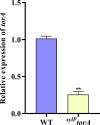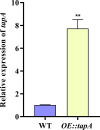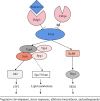The target of rapamycin signaling pathway regulates vegetative development, aflatoxin biosynthesis, and pathogenicity in Aspergillus flavus
- PMID: 38990939
- PMCID: PMC11239180
- DOI: 10.7554/eLife.89478
The target of rapamycin signaling pathway regulates vegetative development, aflatoxin biosynthesis, and pathogenicity in Aspergillus flavus
Abstract
The target of rapamycin (TOR) signaling pathway is highly conserved and plays a crucial role in diverse biological processes in eukaryotes. Despite its significance, the underlying mechanism of the TOR pathway in Aspergillus flavus remains elusive. In this study, we comprehensively analyzed the TOR signaling pathway in A. flavus by identifying and characterizing nine genes that encode distinct components of this pathway. The FK506-binding protein Fkbp3 and its lysine succinylation are important for aflatoxin production and rapamycin resistance. The TorA kinase plays a pivotal role in the regulation of growth, spore production, aflatoxin biosynthesis, and responses to rapamycin and cell membrane stress. As a significant downstream effector molecule of the TorA kinase, the Sch9 kinase regulates aflatoxin B1 (AFB1) synthesis, osmotic and calcium stress response in A. flavus, and this regulation is mediated through its S_TKc, S_TK_X domains, and the ATP-binding site at K340. We also showed that the Sch9 kinase may have a regulatory impact on the high osmolarity glycerol (HOG) signaling pathway. TapA and TipA, the other downstream components of the TorA kinase, play a significant role in regulating cell wall stress response in A. flavus. Moreover, the members of the TapA-phosphatase complexes, SitA and Ppg1, are important for various biological processes in A. flavus, including vegetative growth, sclerotia formation, AFB1 biosynthesis, and pathogenicity. We also demonstrated that SitA and Ppg1 are involved in regulating lipid droplets (LDs) biogenesis and cell wall integrity (CWI) signaling pathways. In addition, another phosphatase complex, Nem1/Spo7, plays critical roles in hyphal development, conidiation, aflatoxin production, and LDs biogenesis. Collectively, our study has provided important insight into the regulatory network of the TOR signaling pathway and has elucidated the underlying molecular mechanisms of aflatoxin biosynthesis in A. flavus.
Keywords: Aspergillus flavus; TOR signaling pathway; aflatoxin; infectious disease; microbiology.
© 2023, Li et al.
Conflict of interest statement
GL, XC, ET, QZ, SW No competing interests declared
Figures



















Update of
- doi: 10.1101/2023.06.18.545466
- doi: 10.7554/eLife.89478.1
- doi: 10.7554/eLife.89478.2
- doi: 10.7554/eLife.89478.3
- doi: 10.7554/eLife.89478.4
Similar articles
-
Ssu72 Regulates Fungal Development, Aflatoxin Biosynthesis and Pathogenicity in Aspergillus flavus.Toxins (Basel). 2020 Nov 13;12(11):717. doi: 10.3390/toxins12110717. Toxins (Basel). 2020. PMID: 33202955 Free PMC article.
-
New Insights of Transcriptional Regulator AflR in Aspergillus flavus Physiology.Microbiol Spectr. 2022 Feb 23;10(1):e0079121. doi: 10.1128/spectrum.00791-21. Epub 2022 Jan 26. Microbiol Spectr. 2022. PMID: 35080432 Free PMC article.
-
The Putative Histone Methyltransferase DOT1 Regulates Aflatoxin and Pathogenicity Attributes in Aspergillus flavus.Toxins (Basel). 2017 Jul 24;9(7):232. doi: 10.3390/toxins9070232. Toxins (Basel). 2017. PMID: 28737735 Free PMC article.
-
Understanding the genetics of regulation of aflatoxin production and Aspergillus flavus development.Mycopathologia. 2006 Sep;162(3):155-66. doi: 10.1007/s11046-006-0050-9. Mycopathologia. 2006. PMID: 16944283 Review.
-
Understanding nonaflatoxigenicity of Aspergillus sojae: a windfall of aflatoxin biosynthesis research.Appl Microbiol Biotechnol. 2007 Oct;76(5):977-84. doi: 10.1007/s00253-007-1116-4. Epub 2007 Jul 31. Appl Microbiol Biotechnol. 2007. PMID: 17665189 Review.
Cited by
-
Non-dikarya fungi share the TORC1 pathway with animals, not with Saccharomyces cerevisiae.Sci Rep. 2025 Feb 18;15(1):5926. doi: 10.1038/s41598-025-89635-4. Sci Rep. 2025. PMID: 39966606 Free PMC article.
-
The TOR Signaling Pathway Governs Fungal Development, Virulence and Ustiloxin Biosynthesis in Ustilaginoidea virens.J Fungi (Basel). 2025 Mar 21;11(4):239. doi: 10.3390/jof11040239. J Fungi (Basel). 2025. PMID: 40278060 Free PMC article.
References
MeSH terms
Substances
Grants and funding
LinkOut - more resources
Full Text Sources
Research Materials

